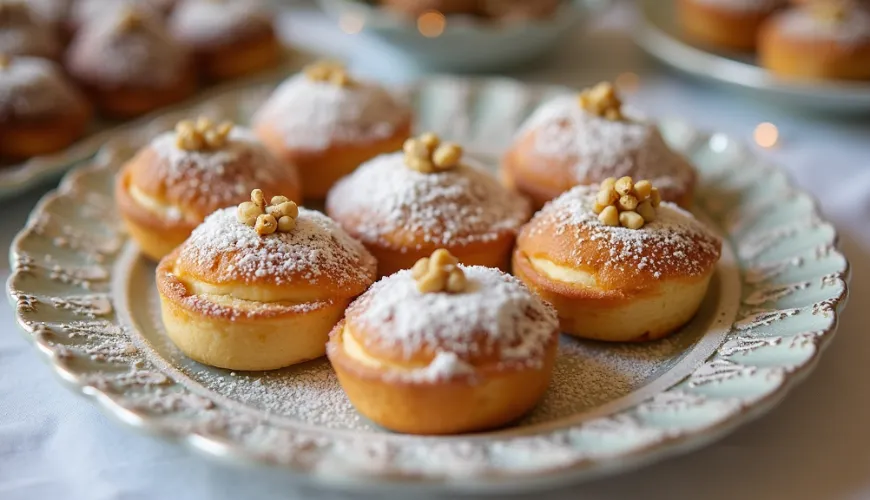
How to Prepare the Perfect Paris-Brest and Impress Your Loved Ones

Legendary Dessert Paris-Brest - A Sweet Tribute to a Cycling Race and the Mastery of French Pastry
When you mention French pastry, most people think of macarons, mille-feuille, or crème brûlée. Among these iconic desserts, there's one that is still quietly cherished by gourmet enthusiasts in the Czech Republic – Paris-Brest. This crispy, creamy ring of choux pastry is not only a testament to pastry craftsmanship but also carries a surprisingly sporty story. And the best part? With a little patience, you can make it at home.
A Dessert Inspired by Cycling
The Paris-Brest dessert was created at the end of the 19th century as a tribute to the then-popular cycling race Paris–Brest–Paris, which first took place in 1891. This 1200-kilometer marathon from Paris to Brittany and back was one of the first long-distance races ever. French pastry chef Louis Durand from Maisons-Laffitte, who lived near the race route, created the dessert in 1910 in the shape of a bicycle wheel – a ring of choux pastry filled with praline hazelnut cream and sprinkled with toasted almonds.
Since then, Paris-Brest has become a classic in French patisseries and bakeries. It's no wonder – it combines the crunchy texture of pastry, the subtly nutty flavor of the cream, and the elegance inherent in French cuisine. But how does a Paris-Brest actually taste?
Imagine a bite where you first hear the gentle crunch of the thin crust of the pastry, followed by the creamy smoothness of the sweet nutty cream with a buttery note. And then the aftertaste – a light bitterness of hazelnuts that beautifully rounds it all off. It's a symphony of flavors that can pleasantly surprise even those who don't usually seek out sweets.
Recipe for Paris-Brest
It's no secret that making Paris-Brest requires some time and skill. But just like riding a bike – once you learn it, it's worth it. If you're tempted to try the authentic Paris-Brest recipe, here's an overview of what you'll need and how to proceed.
Ingredients:
For the choux pastry (pâte à choux):
- 125 ml water
- 125 ml milk
- 100 g butter
- A pinch of salt
- A pinch of sugar
- 150 g plain flour
- 4 eggs (preferably at room temperature)
- Sliced almonds for sprinkling
For the praline cream:
- 100 g hazelnuts
- 100 g sugar
- 250 g butter (softened)
- 250 ml milk
- 3 egg yolks
- 30 g plain flour or cornstarch
- 100 g praline paste (can be substituted with homemade praline)
Method:
First, prepare the choux pastry: In a pot, bring the mixture of water, milk, butter, salt, and sugar to a boil. Once it starts boiling, add the flour and stir vigorously until the dough starts to come away from the sides of the pot. Then remove from the heat and let cool for 5 minutes. Then beat in the eggs, one at a time, making sure the dough remains smooth and glossy.
On a baking sheet lined with parchment paper, draw a circle (about 20 cm in diameter) and use a piping bag to form the dough into a wreath shape. Sprinkle with almond slices and bake at 180 °C for about 35 minutes until the wreath is golden brown. Do not open the oven during baking to prevent the pastry from collapsing.
For the cream, first prepare the praline: Dry roast the nuts, then combine with caramelized sugar and blend into a paste. Bring the milk to a boil, in another bowl mix the egg yolks, starch, and some sugar. While whisking continuously, slowly add the hot milk, then return everything to a low heat until a thick cream forms. Stir the butter and praline paste into the cooled cream.
Finally, cut the baked wreath horizontally in half, fill the bottom half with cream, and cover with the top half. You can decorate with powdered sugar or more nuts.
Does it sound complicated? Perhaps. But the result is breathtaking. Paris-Brest is not just a dessert – it is a celebration of patience and traditional flavors that never go out of style.
When Classic Meets Innovation
Despite its long history, Paris-Brest constantly evolves and adapts. In modern French patisseries, you can find new interpretations – mini versions filled with pistachio cream, raspberry jelly, or caramel light. Famous Parisian pastry chefs like Philippe Conticini and Christophe Michalak have created their own versions, becoming viral hits on social media.
There is also a trend for "healthier" versions. Instead of the classic buttercream, plant-based alternatives are used, with less sugar and whole-grain flour. However, it's important to acknowledge that Paris-Brest remains a dessert where the main role is indulgence, not dietary value. And that's okay. As the famous French chef Pierre Hermé says: "True pleasure is never a sin – if you truly savor it."
Perhaps that's why Paris-Brest is becoming a favorite element on Czech wedding tables, café showcases, or as a challenge for home bakers who want to surprise their loved ones with something unusual.
When is the Right Time for Paris-Brest?
The secret of this dessert lies in its versatility. It's elaborate enough for a birthday celebration, yet delicate enough for afternoon tea. In families that emphasize meticulous home baking, Paris-Brest can be a symbol of festive tradition passed down from generation to generation. And maybe it will become just that in your household, as it has been in France for over a hundred years – a symbol of the fusion of craft, passion, and history.
Imagine the impression you'll make when, instead of a traditional cake, you bring a homemade Paris-Brest to a celebration. Not only will you captivate the taste buds of your guests, but you'll also offer them something with a story. And that's precisely what often lacks in the kitchen – stories that connect people through food.
So next time someone mentions Paris-Brest, don't just think of the city and the race. Remember the crunchy wreath filled with velvety cream that carries traces of history, elegance, and indulgence. And maybe, just maybe, you'll be inspired to try it at home – because some challenges are simply worth it.

